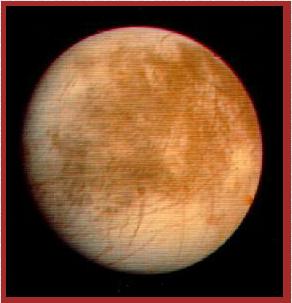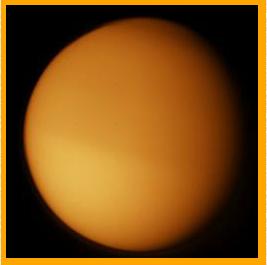 Lesson 7:
Lesson 7:
 Life in the Solar System
Life in the Solar System
|
 7.6
7.6
 Looking Elsewhere: Life on Europa?
Looking Elsewhere: Life on Europa?

|

|
Figure 7.6.1 Jupiter's moon, Europa.
Jupiter's moon, Europa. |
Until a couple years ago, Mars has always been the top candidate for a
planet other than Earth where life might be found. What if Mars
disappoints us? Are there other candidates in the solar system?
The answer is yes, and the next-best shot at finding extra-terrestrial
life forms is on Europa, a moon of the planet Jupiter. Right now,
there is no other body in the solar system that attracts as much
scientific attention as this bright strange-looking moon, the
smallest of Jupiter's four large satellites. Shown below, top to
bottom (and as you would approach them moving outward from Jupiter)
are Io, Europa, Ganymede and Callisto.

|
 |
Figure 7.6.2 The Galilean moons of Jupiter:
The Galilean moons of Jupiter:
Io, Europa, Ganymede and Callisto.
|
Europa seems like a good bet. Life might be a bit strange, but perhaps not a
lot stranger than the life forms recently found around hot vents in
the abyssal ocean. Liquid water and sources of energy are the
essential prerequisites for Life. Europa might well have them. Strong
tidal heat could keep the inside of Europa warm enough to have liquid
water beneath a layer of ice. Therefore, any organic compounds would
be mobile, in water. They could interact.
Let's have a closer look at Europa as a possible host of Life. Europa is
the fourth largest moon of Jupiter and the sixth largest moon in the
solar system. Europa's surface is covered with ice. From the pictures
taken by Galileo (the space craft, not the astronomer), its surface
looks like broken glass that is repaired by icy glue oozing up from
below. Low ridges, straight and curved, crisscross the surface. Flows
and fractures, pits and frozen "puddles" - all hint at a unique geologic history.
Due to its smooth surface, it is the brightest moon is the solar system.
It is quite unlike its fellow moons Callisto and Ganymede with their
heavily cratered crusts. Europa has almost a complete absence of
craters as well as almost no vertical relief. This interesting
feature makes it difficult to find out the age of this moon.
Geologists determine the relative age of a surface by counting the
number of impact craters. We all know our Moon has many craters. It
suggests that our moon has been geologically inactive for about 4000
million years. In contrast, there is very little evidence of impacts
on the surface of Europa. Unless Europa is fortunate enough to
somehow avoid the impacts suffered throughout the rest of the solar
system, it must have gone through some kind of geological process
that erased the evidence of almost all of those impacts.
Europa has an icy crust that has been severely fractured, as indicated by
the dark linear, curved, and wedged-shaped bands seen in images of the
surface.These fractures have broken the crust into plates as large as 30
kilometers (18.5 miles) across. Areas between the plates are filled
with material that was probably icy slush contaminated with rocky
debris. Some individual plates were separated and rotated into new
positions.

|
 |
Figure 7.6.3 Surface of Europa showing fractured crust and
Surface of Europa showing fractured crust and
absence of any cratering.
|
By studying Europa's density we can tell that it has a shell of water
ice, parts of which could be liquid. Models of Europa's interior show
that beneath a thin 5 km (3 miles) crust of water ice, Europa may
have oceans as deep as 50 km (30 miles) or more. There is some
evidence indicating that Europa may be slushy just beneath the icy
crust and possibly even warmer at greater depths. The evidence
includes a strangely shallow impact crater, chunky textured surfaces
like icebergs, and gaps where new icy crust seems to have formed
between continent-sized plates of ice.
Thus, much of the evidence points to a mobile surface provided by
liquid water. Liquid water, scientists believe, could exist below the surface because of
internal tidal heating from gravitational interactions with Jupiter and the other Galilean moons.
(The Galilean moons are the four shown above, so named because they were first
observed by Galileo.)

|
 |
Figure 7.6.4 Saturn's moon, Titan.
Saturn's moon, Titan.
|
Another planetoid mentioned in connection with Life in the solar system is
Titan, the largest of the moons of Saturn. Titan has an atmosphere
largely made up of nitrogen, with less than one percent of methane.
The surface pressure of Titan's atmosphere is higher than that of Earth, but the
temperature is extremely cold. A rich assortment of organic molecules is found in Titan's
atmosphere, as products of the ammonia/methane chemistry. The mixture includes hydrogen cyanide,
a compound in the path to the synthesis of amino acids. This finding
has led to speculations that primitive life forms might be present.
The low temperatures on this satellite make it unlikely.
|





















